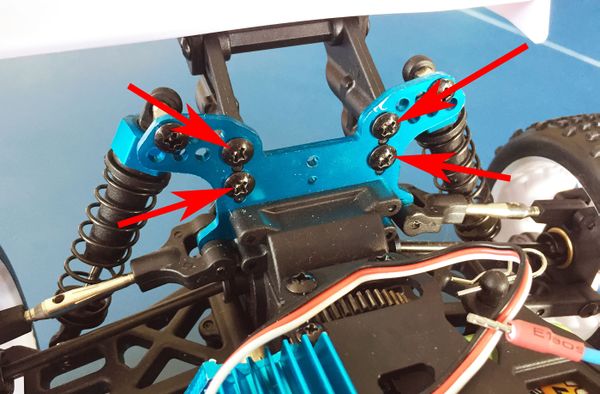Difference between revisions of "Donkey Car"
| Line 40: | Line 40: | ||
[[File:dc-20-remove-screws.jpg|600px]] | [[File:dc-20-remove-screws.jpg|600px]] | ||
| − | Fit the blue laser-cut bracket labelled "REAR" onto the chassis, using the original screws to go through the bracket and into the spoiler mount. Tighten the screws gently so you don't crack the bracket. It doesn't need to be tight: | + | Fit the blue laser-cut bracket labelled "REAR" onto the chassis, using the original screws to go through the bracket and into the spoiler mount. Tighten the screws gently so you don't crack the bracket. It doesn't need to be very tight: |
[[File:dc-30-rear-mount.jpg|600px]] | [[File:dc-30-rear-mount.jpg|600px]] | ||
| + | |||
| + | Put the 2 x 10mm M3 bolts through the blue laser-cut bracket labelled "FRONT", and through the chassis at the front: | ||
| + | |||
| + | [[File:dc-40-front-mount.jpg|600px]] | ||
| + | |||
| + | Use the 2 x M3 nuts to secure the bracket. Once again, it doesn't need to be very tight. Just tight enough to stop it vibrating loose. | ||
| + | |||
| + | [[File:dc-50-front-mount-nuts.jpg|600px]] | ||
| + | |||
| + | Fit the white base plate onto the blue mounting brackets. WARNING: The bracket can be fitted upside down. The correct orientation has the small indentation to the right, and the hole to the left: | ||
| + | |||
| + | [[File:dc-60-base.jpg|600px]] | ||
| + | |||
| + | Wrap the rubber bands around the mounting brackets to secure the base plate. | ||
| + | |||
| + | Examine the white laser-cut camera mounting bracket, which has slots cut through one side of the corflute so that the tabs can bend in one direction. Bend the tabs, and begin to slide them into the slots in the base plate: | ||
| + | |||
| + | [[File:dc-65-camera-mount.jpg|600px]] | ||
| + | |||
| + | Slide the camera mount forward so that the tabs clip into the slots: | ||
| + | |||
| + | [[File:dc-70-camera-mount.jpg|600px]] | ||
| + | |||
| + | When the mount is all the way forward, clip the rear tab down into the slot: | ||
| + | |||
| + | [[File:dc-80-camera-mount.jpg|600px]] | ||
Revision as of 10:03, 20 January 2019
Before You Begin
There are several steps where it's possible to destroy the Raspberry Pi, the camera, or other expensive parts of the kit. Please don't rush! Read these instructions carefully, and check before making any soldered connections, attaching the camera, or attaching power.
WARNING: Do NOT connect or disconnect items such as the servo or speed controller while power is applied. During testing we accidentally destroyed several servos by doing this. Make sure everything is powered down before doing ANY work on the car.
Parts Required
There are 4 major items included in your kit:
1. 1/16th scale RC car chassis, with a steering servo, a motor speed controller, and a NiMH battery. 2. Battery charger with AU/NZ adapter. 3. White rectangular laser-cut corflute base plate. 4. A bag of small parts.
The bag should contain:
* 1 x Raspberry Pi model 3 * 1 x Raspberry Pi camera and flex cable * 1 x Donkey Car Hat for Raspberry Pi (in anti-static bag) * 1 x Freetronics PR28V voltage regulator, already configured for 5V output (in anti-static bag) * 1 x laser-cut corflute bracket * 2 x blue laser-cut brackets * 1 x 5mm 2-way screw terminal * 4 x small cable ties * 4 x plastic spacers * 2 x 12-way header sockets * 1 x 4-way pin header * 2 x 3-way pin headers * 2 x 1-way pin headers * 2 x 10mm M3 bolts * 2 x M3 nuts
You will also be given a micro SD card and adapter separately, pre-loaded with Raspbian and the necessary software.
Chassis Preparation
Use a Philips-head screwdriver to remove the 4 black screws holding the rear spoiler mount onto the chassis:
Fit the blue laser-cut bracket labelled "REAR" onto the chassis, using the original screws to go through the bracket and into the spoiler mount. Tighten the screws gently so you don't crack the bracket. It doesn't need to be very tight:
Put the 2 x 10mm M3 bolts through the blue laser-cut bracket labelled "FRONT", and through the chassis at the front:
Use the 2 x M3 nuts to secure the bracket. Once again, it doesn't need to be very tight. Just tight enough to stop it vibrating loose.
Fit the white base plate onto the blue mounting brackets. WARNING: The bracket can be fitted upside down. The correct orientation has the small indentation to the right, and the hole to the left:
Wrap the rubber bands around the mounting brackets to secure the base plate.
Examine the white laser-cut camera mounting bracket, which has slots cut through one side of the corflute so that the tabs can bend in one direction. Bend the tabs, and begin to slide them into the slots in the base plate:
Slide the camera mount forward so that the tabs clip into the slots:
When the mount is all the way forward, clip the rear tab down into the slot:








